Abstract
We have determined whether the gene encoding dihydrofolate reductase (5,6,7,8-tetrahydrofolate: NADP+ oxidoreductase, EC 1.5.1.3) varies spontaneously in gene copy number in cells in vitro. Cells were stained under nonselective conditions with fluoresceinated methotrexate, which binds quantitatively to dihydrofolate reductase. Cells with the highest fluorescence were collected by a fluorescence-activated cell sorter and subsequently grown in the absence of methotrexate. At no time during the experiment were the cells placed under metabolic stress. After 10 successive rounds of growth and sorting, the derived population showed a 50-fold increase in fluorescence intensity, was highly resistant to methotrexate, and was amplified 40-fold in content of dihydrofolate reductase gene. We also found that cells already having amplified genes can undergo increases or decreases in their fluorescence and in gene copy number even more rapidly (at rates as high as 3 X 10(-2) amplification events per cell division) than do parental cells (ca. 10(-3) events per division). We therefore conclude that gene amplification can occur spontaneously in cells and that the rate of its occurrence varies with gene copy number.
Full text
PDF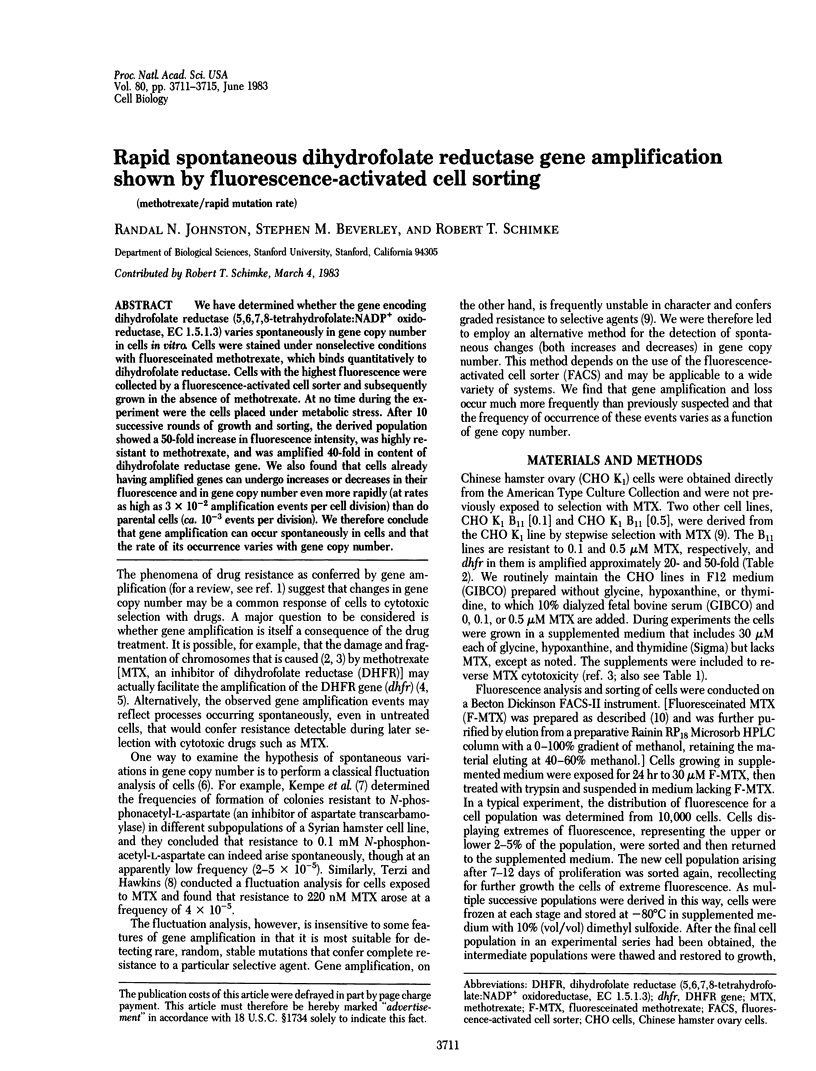
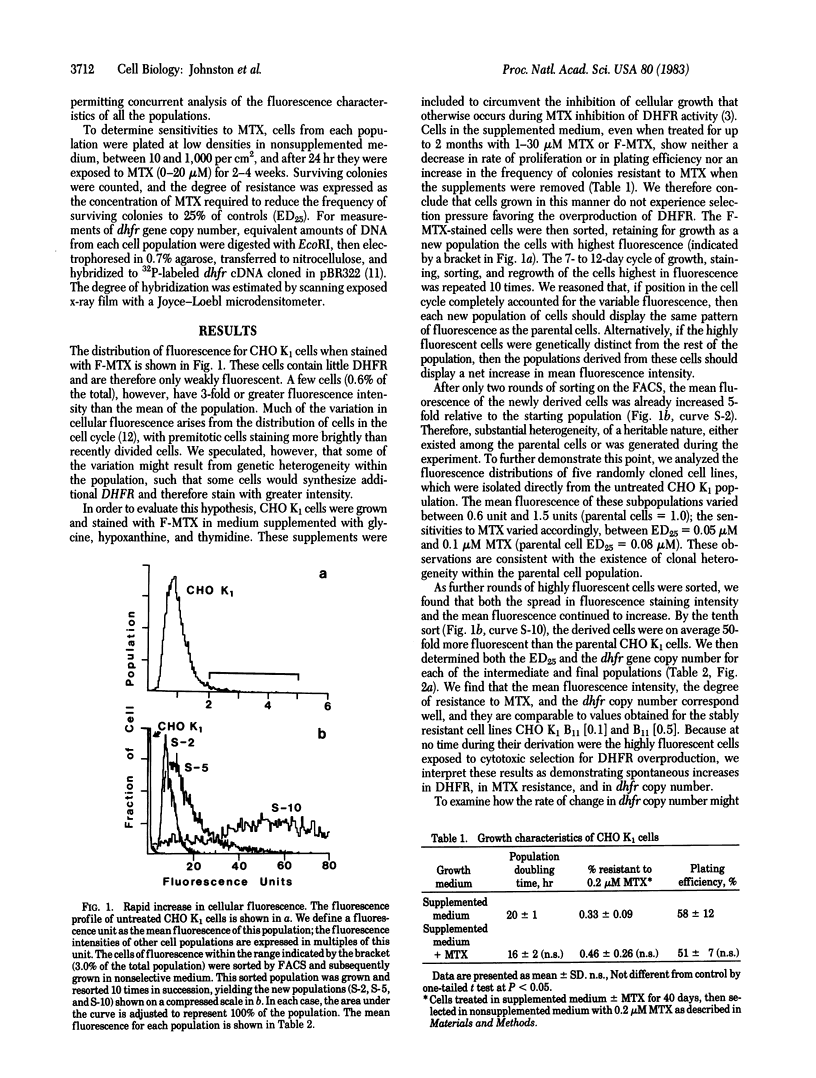
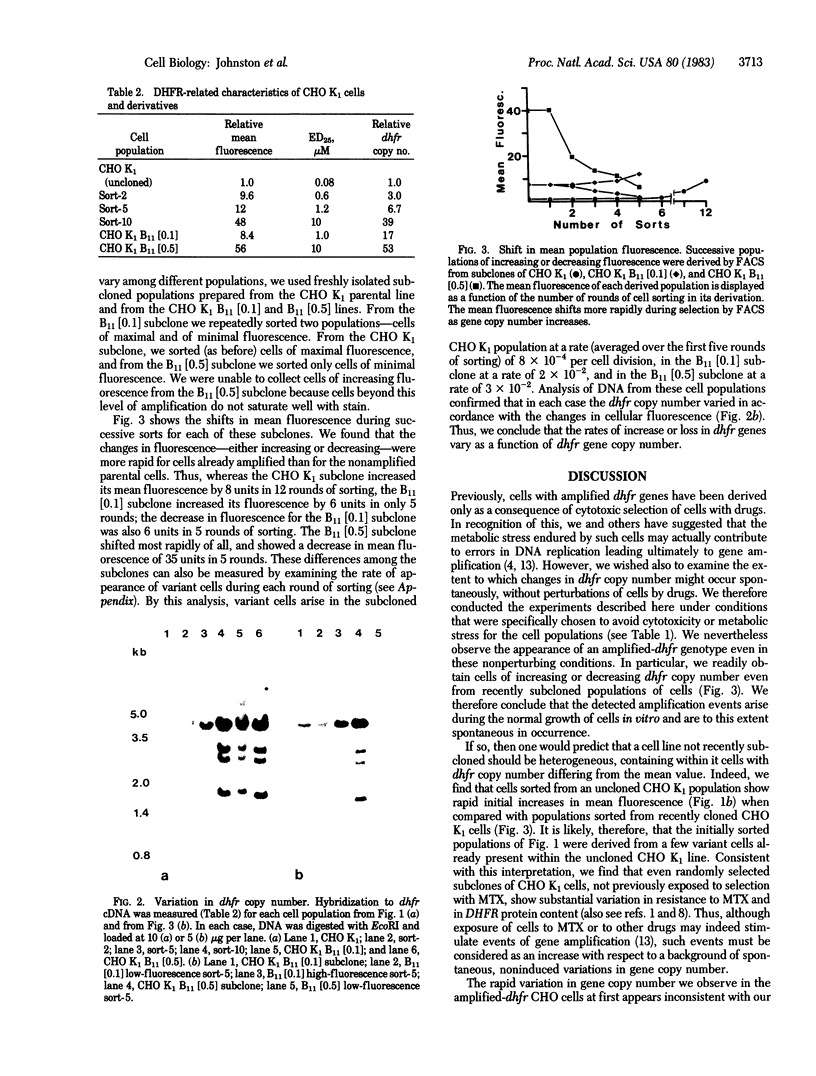
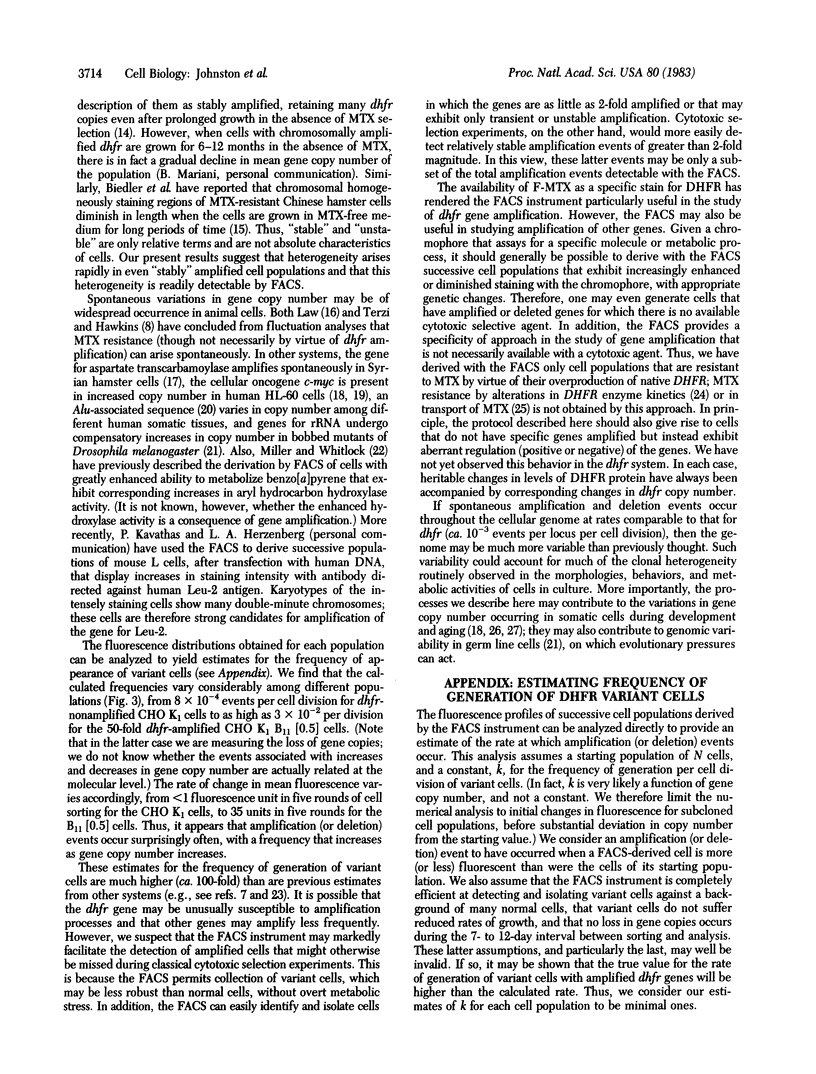
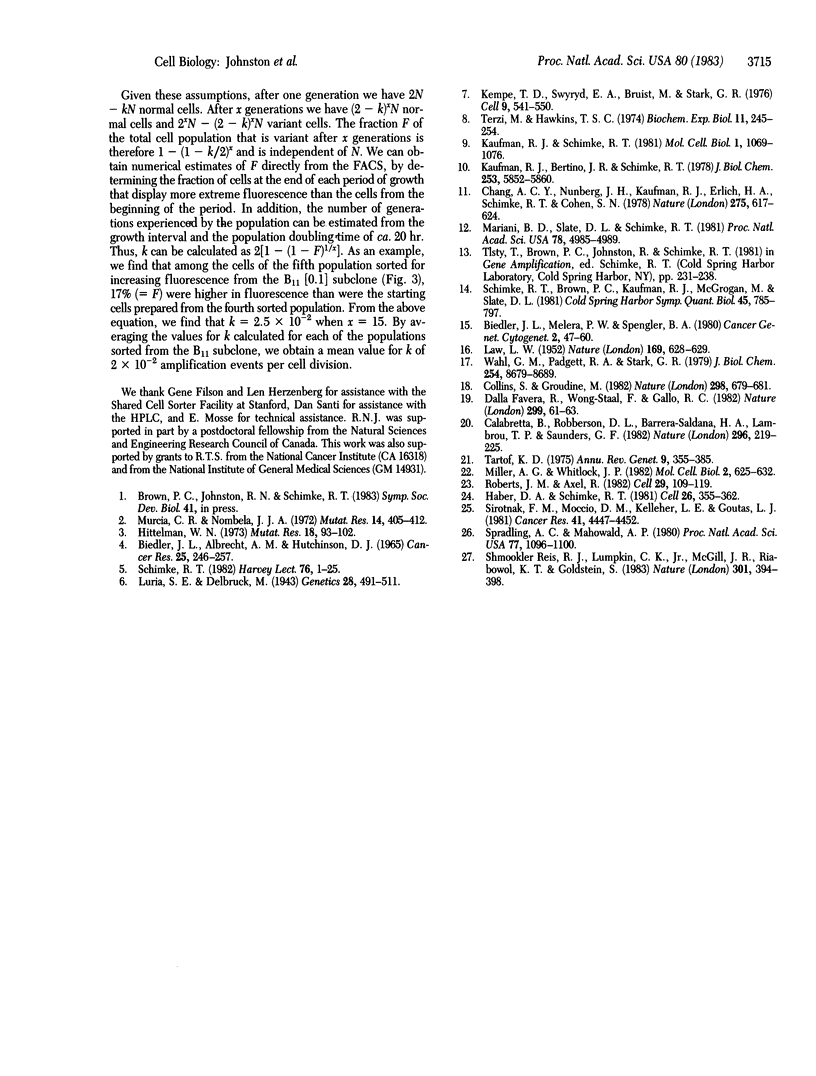
Images in this article
Selected References
These references are in PubMed. This may not be the complete list of references from this article.
- BIEDLER J. L., ALBRECHT A. M., HUTCHISON D. J. CYTOGENETICS OF MOUSE LEUKEMIA L1210. I. ASSOCIATION OF A SPECIFIC CHROMOSOME WITH DIHYDROFOLATE REDUCTASE ACTIVITY IN AMETHOPTERIN-TREATED SUBLINES. Cancer Res. 1965 Feb;25:246–257. [PubMed] [Google Scholar]
- Calabretta B., Robberson D. L., Barrera-Saldaña H. A., Lambrou T. P., Saunders G. F. Genome instability in a region of human DNA enriched in Alu repeat sequences. Nature. 1982 Mar 18;296(5854):219–225. doi: 10.1038/296219a0. [DOI] [PubMed] [Google Scholar]
- Chang A. C., Nunberg J. H., Kaufman R. J., Erlich H. A., Schimke R. T., Cohen S. N. Phenotypic expression in E. coli of a DNA sequence coding for mouse dihydrofolate reductase. Nature. 1978 Oct 19;275(5681):617–624. doi: 10.1038/275617a0. [DOI] [PubMed] [Google Scholar]
- Collins S., Groudine M. Amplification of endogenous myc-related DNA sequences in a human myeloid leukaemia cell line. Nature. 1982 Aug 12;298(5875):679–681. doi: 10.1038/298679a0. [DOI] [PubMed] [Google Scholar]
- Dalla-Favera R., Wong-Staal F., Gallo R. C. Onc gene amplification in promyelocytic leukaemia cell line HL-60 and primary leukaemic cells of the same patient. Nature. 1982 Sep 2;299(5878):61–63. doi: 10.1038/299061a0. [DOI] [PubMed] [Google Scholar]
- Haber D. A., Schimke R. T. Unstable amplification of an altered dihydrofolate reductase gene associated with double-minute chromosomes. Cell. 1981 Nov;26(3 Pt 1):355–362. doi: 10.1016/0092-8674(81)90204-x. [DOI] [PubMed] [Google Scholar]
- Hittelman W. N. The type and time of occurrence of aminopterin-induced chromosome aberrations in cultured Potorous cells. Mutat Res. 1973 Apr;18(1):93–102. doi: 10.1016/0027-5107(73)90024-9. [DOI] [PubMed] [Google Scholar]
- Kaufman R. J., Bertino J. R., Schimke R. T. Quantitation of dihydrofolate reductase in individual parental and methotrexate-resistant murine cells. Use of a fluorescence activated cell sorter. J Biol Chem. 1978 Aug 25;253(16):5852–5860. [PubMed] [Google Scholar]
- Kaufman R. J., Schimke R. T. Amplification and loss of dihydrofolate reductase genes in a Chinese hamster ovary cell line. Mol Cell Biol. 1981 Dec;1(12):1069–1076. doi: 10.1128/mcb.1.12.1069. [DOI] [PMC free article] [PubMed] [Google Scholar]
- Kempe T. D., Swyryd E. A., Bruist M., Stark G. R. Stable mutants of mammalian cells that overproduce the first three enzymes of pyrimidine nucleotide biosynthesis. Cell. 1976 Dec;9(4 Pt 1):541–550. doi: 10.1016/0092-8674(76)90036-2. [DOI] [PubMed] [Google Scholar]
- LAW L. W. Origin of the resistance of leukaemic cells to folic acid antagonists. Nature. 1952 Apr 12;169(4302):628–629. doi: 10.1038/169628a0. [DOI] [PubMed] [Google Scholar]
- Luria S. E., Delbrück M. Mutations of Bacteria from Virus Sensitivity to Virus Resistance. Genetics. 1943 Nov;28(6):491–511. doi: 10.1093/genetics/28.6.491. [DOI] [PMC free article] [PubMed] [Google Scholar]
- Mariani B. D., Slate D. L., Schimke R. T. S phase-specific synthesis of dihydrofolate reductase in Chinese hamster ovary cells. Proc Natl Acad Sci U S A. 1981 Aug;78(8):4985–4989. doi: 10.1073/pnas.78.8.4985. [DOI] [PMC free article] [PubMed] [Google Scholar]
- Miller A. G., Whitlock J. P., Jr Heterogeneity in the rate of benzo[a]pyrene metabolism in single cells: quantitation using flow cytometry. Mol Cell Biol. 1982 Jun;2(6):625–632. doi: 10.1128/mcb.2.6.625. [DOI] [PMC free article] [PubMed] [Google Scholar]
- Roberts J. M., Axel R. Gene amplification and gene correction in somatic cells. Cell. 1982 May;29(1):109–119. doi: 10.1016/0092-8674(82)90095-2. [DOI] [PubMed] [Google Scholar]
- Rodriguez Murcia C., Arroyo Nombela J. J. Cytological aberrations produced by methotrexate in mouse ascites tumours. Mutat Res. 1972 Apr;14(4):405–412. doi: 10.1016/0027-5107(72)90138-8. [DOI] [PubMed] [Google Scholar]
- Schimke R. T., Brown P. C., Kaufman R. J., McGrogan M., Slate D. L. Chromosomal and extrachromosomal localization of amplified dihydrofolate reductase genes in cultured mammalian cells. Cold Spring Harb Symp Quant Biol. 1981;45(Pt 2):785–797. doi: 10.1101/sqb.1981.045.01.097. [DOI] [PubMed] [Google Scholar]
- Schimke R. T. Gene amplification and methotrexate resistance in cultured animal cells. Harvey Lect. 1980;76:1–25. [PubMed] [Google Scholar]
- Shmookler Reis R. J., Lumpkin C. K., Jr, McGill J. R., Riabowol K. T., Goldstein S. Extrachromosomal circular copies of an 'inter-Alu' unstable sequence in human DNA are amplified during in vitro and in vivo ageing. Nature. 1983 Feb 3;301(5899):394–398. doi: 10.1038/301394a0. [DOI] [PubMed] [Google Scholar]
- Sirotnak F. M., Moccio D. M., Kelleher L. E., Goutas L. J. Relative frequency and kinetic properties of transport-defective phenotypes among methotrexate-resistant L1210 clonal cell lines derived in vivo. Cancer Res. 1981 Nov;41(11 Pt 1):4447–4452. [PubMed] [Google Scholar]
- Spradling A. C., Mahowald A. P. Amplification of genes for chorion proteins during oogenesis in Drosophila melanogaster. Proc Natl Acad Sci U S A. 1980 Feb;77(2):1096–1100. doi: 10.1073/pnas.77.2.1096. [DOI] [PMC free article] [PubMed] [Google Scholar]
- Tartof K. D. Redundant genes. Annu Rev Genet. 1975;9:355–385. doi: 10.1146/annurev.ge.09.120175.002035. [DOI] [PubMed] [Google Scholar]
- Wahl G. M., Padgett R. A., Stark G. R. Gene amplification causes overproduction of the first three enzymes of UMP synthesis in N-(phosphonacetyl)-L-aspartate-resistant hamster cells. J Biol Chem. 1979 Sep 10;254(17):8679–8689. [PubMed] [Google Scholar]



